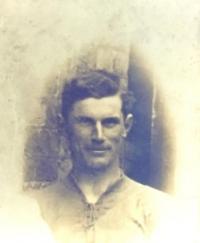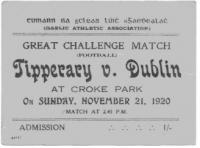Bloody Sunday remembered at Croke Park
Published in 20th-century / Contemporary History, Issue 1 (Jan/Feb 2011), News, Revolutionary Period 1912-23, Volume 19
Tipperary footballer Michael Hogan—the only player killed on Bloody Sunday. (GAA Museum)
Bloody Sunday began with the attacks of Michael Collins’s ‘squad’ upon the British intelligence network in Dublin, and specifically the so-called ‘Cairo Gang’. These were the ‘particular ones’ whom Collins felt were bringing British intelligence closer and closer to the heart of the republican movement. By the end of the day, news of the deaths at Croke Park would leave a nation in shock. And before the day was done three more were to die in Dublin Castle—IRA commanders Dick McKee and Peadar Clancey and Gaelic Leaguer Conor Clune.
The Irish Times of the next morning ran the ‘official’ version, portraying those gunned down at Croke Park as legitimate targets. The report noted that:
‘It is believed that a number of gunmen came to Dublin today under the guise of a wish to attend a Gaelic football match between Dublin and Tipperary, but that their real motive was to take part in a series of murderous outrages which took place in Dublin this morning.’
It was an attempt to criminalise the victims of the Croke Park shootings—three of those killed were children, aged ten, eleven and fourteen.
The fourteen lives lost at Croke Park are remembered today at a beautiful monument inside the grounds, which show the Dublin and Tipperary teams of that day alongside the names of the dead. The event is marked annually with a commemorative lecture, and this year Tim Pat Coogan and William Murphy (Mater Dei Institute of Education, DCU) presented papers. Dr Murphy’s was broad in its scope and looked at the relationship between the GAA and the republican movement. It was based on witness statements to the Bureau of Military History, newspaper reports and grassroots GAA sources. One is a GAA report published in the Irish Independent just prior to its county conventions in 1923, which noted that:
‘In 1916, when Pearse and his companions unfurled the flag of liberty, the men of the hurling and football fields rolled in from far and near, and it is no exaggeration to say that they formed the backbone of that company.’
 In fact the relationship between the GAA and the republican movement was not always quite so clear-cut. What, for example, was the relationship between local GAA clubs and recruitment for the Great War? The assertion of Cornelius Murphy in his Bureau of Military History witness statement that ‘90 per cent of the GAA was just GAA’ suggests that perhaps the GAA did function primarily as a sports organisation, even in the midst of the War of Independence. Murphy’s paper was particularly interesting for the use of grassroots sources, where we see the effects of national events on individual clubs and communities. It is clear that to the police and military intelligence GAA meant IRA, but just what the IRA meant to the GAA themselves is an area still requiring much study.
In fact the relationship between the GAA and the republican movement was not always quite so clear-cut. What, for example, was the relationship between local GAA clubs and recruitment for the Great War? The assertion of Cornelius Murphy in his Bureau of Military History witness statement that ‘90 per cent of the GAA was just GAA’ suggests that perhaps the GAA did function primarily as a sports organisation, even in the midst of the War of Independence. Murphy’s paper was particularly interesting for the use of grassroots sources, where we see the effects of national events on individual clubs and communities. It is clear that to the police and military intelligence GAA meant IRA, but just what the IRA meant to the GAA themselves is an area still requiring much study.
 In fact the relationship between the GAA and the republican movement was not always quite so clear-cut. What, for example, was the relationship between local GAA clubs and recruitment for the Great War? The assertion of Cornelius Murphy in his Bureau of Military History witness statement that ‘90 per cent of the GAA was just GAA’ suggests that perhaps the GAA did function primarily as a sports organisation, even in the midst of the War of Independence. Murphy’s paper was particularly interesting for the use of grassroots sources, where we see the effects of national events on individual clubs and communities. It is clear that to the police and military intelligence GAA meant IRA, but just what the IRA meant to the GAA themselves is an area still requiring much study.
In fact the relationship between the GAA and the republican movement was not always quite so clear-cut. What, for example, was the relationship between local GAA clubs and recruitment for the Great War? The assertion of Cornelius Murphy in his Bureau of Military History witness statement that ‘90 per cent of the GAA was just GAA’ suggests that perhaps the GAA did function primarily as a sports organisation, even in the midst of the War of Independence. Murphy’s paper was particularly interesting for the use of grassroots sources, where we see the effects of national events on individual clubs and communities. It is clear that to the police and military intelligence GAA meant IRA, but just what the IRA meant to the GAA themselves is an area still requiring much study.
Tim Pat Coogan focused on Bloody Sunday itself, particularly on the recollections of Caroline Woodcock, wife of Col. Wilfrid James Woodcock, who was targeted by Collins’s squad yet survived: ‘I think it speaks well for the magnificent discipline of the regiment that in spite of the fierce anger they felt, not one act of reprisal in any shape or form took place that night or during the ensuing week’. Likewise, Winston Churchill would insist that no act of reprisal was taken in response to the assassinations of intelligence agents on the morning of 21 November 1920. Coogan also spoke about the cover-up in the aftermath of Bloody Sunday in Croke Park, and drew comparisons to events at a much later date in the Bogside of Derry.
The following day, on the actual anniversary of Bloody Sunday, a walking tour of the stadium was conducted by John Campbell of the Croke Park Museum, which gave an excellent insight into the layout of Croke Park at the time and the changes made since. We were shown where the Belvedere grounds would have been located, adjoining the boundary wall of the Cusack Stand, and where the Dublin Fire Brigade horse-drawn ambulance would have entered the field of play. John Campbell related some personal stories of those who lost their lives and their loved ones, for example the brother of Tipperary player Michael Hogan, who was advised not to attend his brother’s funeral owing to being on the run himself.
All in all, the events of the weekend, on the first Bloody Sunday to fall on a Sunday for many years, served to remember and commemorate the victims of that day at Croke Park. HI
Donal Fallon is editor of ‘Come Here To Me’, a blog on Dublin life and culture, http://comeheretome.wordpress.com/.
'
















